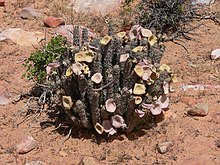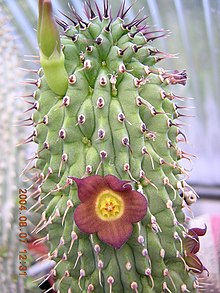Hoodia
| Hoodia | |
|---|---|

| |
| Hoodia gordonii | |
| Scientific classification | |
| Kingdom: | Plantae |
| Clade: | Tracheophytes |
| Clade: | Angiosperms |
| Clade: | Eudicots |
| Clade: | Asterids |
| Order: | Gentianales |
| Family: | Apocynaceae |
| Subfamily: | Asclepiadoideae |
| Tribe: | Ceropegieae |
| Genus: | Hoodia Sweet ex Decne. |
Hoodia (/ˈhʊdiə/; known locally as "ghaap" or "bobbejaanghaap")[1] is a genus of flowering plants in the family Apocynaceae, under the subfamily Asclepiadoideae, native to Southern Africa.[2]
One species of Hoodia in particular, Hoodia gordonii, has achieved a degree of fame and controversy, after being investigated for use as a possible appetite suppressant.
Description[edit]


The group was first described as a genus in 1844.[3][4]
Hoodia are stem succulents, described as "cactiform" because of their remarkable similarity to the unrelated cactus family. They have a branching, shrub-like form, and the largest species (Hoodia parviflora) can grow to the size of a tree — over 2 m (6 ft 7 in) in height.
The flowers are extremely variable in size — from less than 1 cm, to almost 20 cm in diameter, depending on the species. Flowers appear in large numbers, always near the tops of the stems. Those of larger-flowered species (such as Hoodia gordonii) are often a papery pink-tan colour, plate-shaped, with an unpleasant smell to attract their fly pollinators. The smaller, darker flowers of some species have a far stronger and more unpleasant smell than the larger flowers.
Distribution[edit]
The genus Hoodia is restricted to the arid regions in the western part of southern Africa, ranging from western South Africa to central Namibia and as far north as southern Angola. It is especially common in the Namib desert and in the Orange River valley. Typical habitat is rocky slopes and open stone plains. Plants usually germinate in the shelter of bushes or rocks, but survive in the open as adult plants.
- Species[5]
- Hoodia albispina - South Africa
- Hoodia alstonii - South Africa
- Hoodia bainii - South Africa
- Hoodia barklyi - South Africa
- Hoodia burkei - South Africa
- Hoodia currorii - tropical Africa
- Hoodia dregei - South Africa
- Hoodia flava - South Africa
- Hoodia gibbosa - Namibia
- Hoodia gordonii - Namibia
- Hoodia husabensis - Namibia
- Hoodia juttae - Namibia
- Hoodia langii - Botswana, Namibia, Cape Province
- Hoodia lugardii - tropical Africa
- Hoodia macrantha - Namibia
- Hoodia montana - Brandberg in Namibia
- Hoodia mossamedensis - Angola
- Hoodia officinalis - Namibia, Cape Province
- Hoodia parviflora - South Africa
- Hoodia pedicellata - Namibia
- Hoodia pilifera - South Africa
- Hoodia rosea - Cape Province
- Hoodia ruschii - Great Namaqualand in Namibia
- Hoodia rustica - Cape Province
- Hoodia triebneri - Namibia
Several of the small-flowered species of Hoodia were formerly in a separate genus, Trichocaulon ("ghaap"), but have been moved into the genus Hoodia, and the two groups are now synonymous. Phylogenetic studies have shown the genus Hoodia to be monophyletic, and most closely related to the stapeliad genus Lavrania. Marginally more distantly related is a sister branch of related genera including Larryleachia, Richtersveldia and Notechidnopsis.[6]
Uses and horticulture[edit]

Supplement[edit]
Hoodia gordonii is traditionally used by the San people (Bushmen) of the Namib desert as an appetite suppressant as part of their indigenous knowledge about survival in the harsh desert conditions. In 2006, the plant became internationally known, after a marketing campaign falsely claimed that its use as a dietary supplement was an appetite suppressant for weight loss.[7] As of 2018, there is no high-quality clinical research showing that hoodia has actions as an appetite suppressant or is effective for weight loss.[8]
In a case of biopiracy, bioprospectors from South Africa's Council for Scientific and Industrial Research (CSIR) realized that the plant was marketable and patented its use as an appetite suppressant without recognizing the Sans' traditional claims to the knowledge of the plant and its uses.[9][10] The patent was later sold to Unilever, which marketed hoodia products as diet supplements.[11][12][13] In 2003, the South African San Council entered into a benefit sharing agreement with CSIR in which they would receive from 6 to 8% of the revenue from the sale of Ho. gordonii products, money which would be deposited in a trust for all San peoples across Southern Africa.[14]
Horticulture[edit]
Several species are grown as garden plants, and one species, H. gordonii, is being investigated for use as an appetite suppressant.[15] However, in 2008, UK-based Unilever PLC, one of the largest packaged-food firms in the world, abandoned plans to use hoodia in a range of diet products. In a document on Unilever's website entitled "Sustainable Development 2008: An Overview", signed by Paul Polman, CEO, Unilever states: "During 2008, having invested 20 million [pounds] in R&D, Unilever abandoned plans to use the slimming extract hoodia in a range of diet products. We stopped the project because our clinical studies revealed that products using hoodia would not meet our strict standards of safety and efficacy."
Many Hoodia species are protected plants. Hoodia is currently listed in Appendix II to the Convention on International Trade in Endangered Species of Wild Fauna and Flora (CITES), which includes species not currently considered endangered but are at risk if trade is not controlled.[16]
References[edit]
- ^ "Hoodia (Ghaap)". www.biodiversityexplorer.org. Archived from the original on 2009-04-12.
- ^ Stevens PF (2001 onwards) (2007-06-03). "Angiosperm Phylogeny Website: Gentianales". 8. Missouri Botanical Gardens. Retrieved 2008-03-21.
{{cite web}}: CS1 maint: numeric names: authors list (link) - ^ Decaisne, Joseph. 1844 in Candolle, Augustin Pyramus de (ed), Prodromus Systematis Naturalis Regni Vegetabilis 8: 664 in Latin
- ^ "Tropicos | Name - Hoodia Sweet ex Decne". www.tropicos.org. Retrieved September 24, 2019.
- ^ "Search results — The Plant List". www.theplantlist.org. Retrieved September 24, 2019.
- ^ P. Bruyns, C. Klak, P. Hanacek: Evolution of the stapeliads (Apocynaceae-Asclepiadoideae) - repeated major radiation across Africa in an Old World group. Molecular Phylogenetics and Evolution. 2014. v. 77, no. 1, p. 251--263. ISSN 1055-7903.
- ^ Weight Loss Customers Are Being Hoodia-Winked, Harriet Hall, Science-Based Medicine, 11-8-2011, [1]
- ^ "Hoodia". Drugs.com. 2018. Retrieved 23 February 2018.
- ^ Maharaj, V. J.; Senabe, J. V.; Horak, R. M. (November 2008). Hoodia, a case study at CSIR. Science real and relevant: 2nd CSIR Biennial Conference. hdl:10204/2539.
- ^ Maharaj, VJ, Senabe, JV, and Horak, RM. 2008. Hoodia, a case study at CSIR. Science real and relevant: 2nd CSIR Biennial Conference, CSIR International Convention Centre Pretoria, 17&18 November 2008, pp 4
- ^ Indigenous Peoples, Consent and Benefit Sharing: Lessons from the San-Hoodia Case (Rachel Wynberg, Doris Schroeder, Roger Chennells Springer, Dec 4, 2009
- ^ Saskia Vermeylen. 2007. Contextualizing 'Fair' and 'Equitable': The San's Reflections on the Hoodia Benefit-Sharing Agreement Local Environment Vol. 12, Iss. 4,
- ^ "Hot air over Hoodia". www.grain.org. Retrieved September 24, 2019.
- ^ Inventing Hoodia: Vulnerabilities and Epistemic Citizenship. 2011. CSW update APRIL "Archived copy" (PDF). Archived from the original (PDF) on 2014-04-30. Retrieved 2013-11-04.
{{cite web}}: CS1 maint: archived copy as title (link) - ^ Wong, Cathy (2007-09-20). ""What You Need to Know About Hoodia Diet Pills" Website: About.com". Retrieved 2008-08-02.
- ^ "CITES Appendices I, II and III". Archived from the original on 2007-02-03. Retrieved 2008-03-21.
External links[edit]
 Media related to Hoodia at Wikimedia Commons
Media related to Hoodia at Wikimedia Commons- Germplasm Resources Information Network: Hoodia
